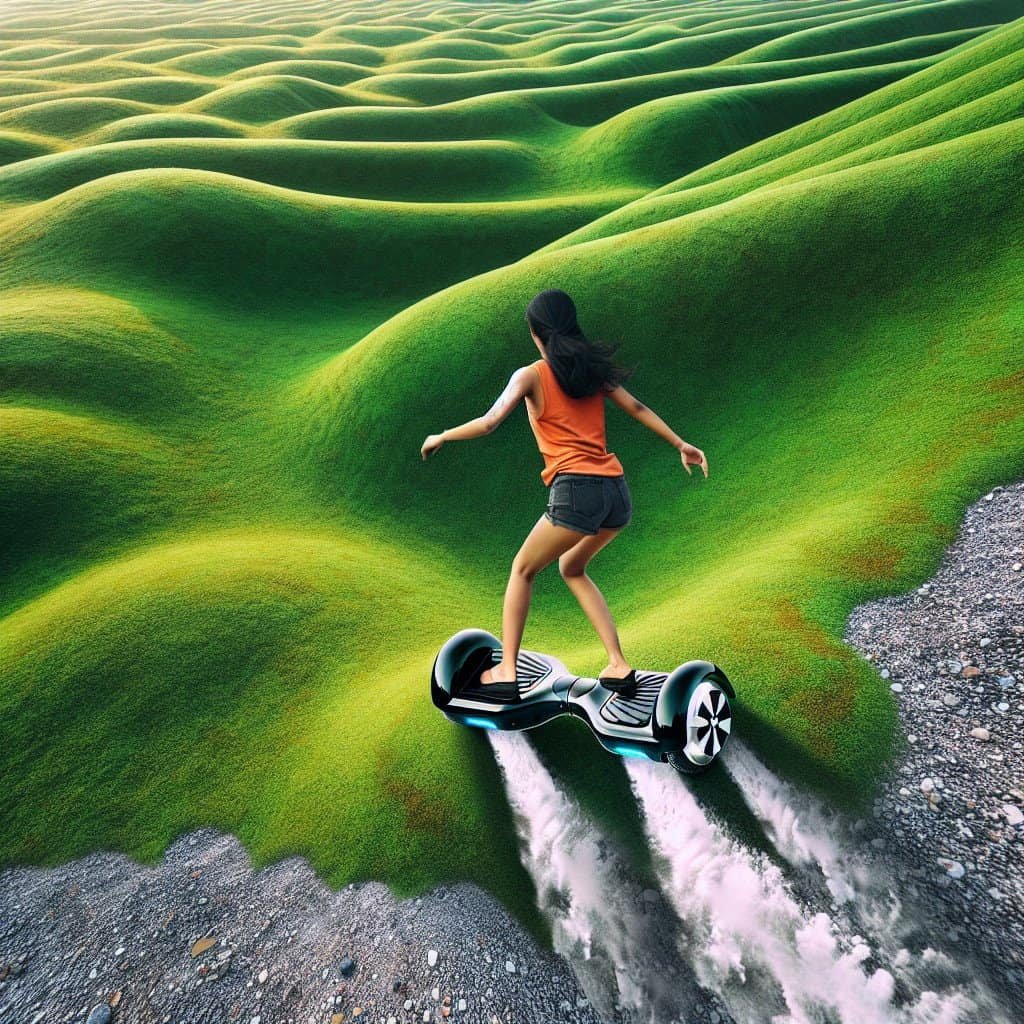Have you ever wondered if you can ride a hoverboard on uneven surfaces like grass or gravel? With their sleek design and futuristic appeal, hoverboards have become a popular mode of transportation. But can they handle off-road conditions? In this article, we will explore whether hoverboards are suitable for uneven surfaces and provide you with some helpful tips to ensure a smooth and enjoyable ride. So, if you’re eager to take your hoverboard on an outdoor adventure, keep reading to find out if it’s a ride you can take on grassy hills or rugged gravel paths.

Hoverboards and Uneven Surfaces
If you’re an avid hoverboard rider, you may have wondered whether it’s possible to ride your hoverboard on uneven surfaces such as grass or gravel. In this article, we will explore the challenges and tips associated with riding hoverboards on these types of surfaces. We will also provide some useful information on choosing the right hoverboard for uneven terrains and safety precautions to keep in mind.
Grass and Hoverboards
Riding a hoverboard on grass can be quite challenging due to the uneven and unpredictable nature of the surface. The thick and soft texture of grass can make it difficult for the wheels of your hoverboard to grip the ground effectively, resulting in a less stable and controlled ride. Uneven patches and dips in the grass can also make it harder to maintain your balance.
To overcome these challenges, there are a few tips you can follow. First, it’s important to choose a hoverboard with large wheels and good traction. This will increase the chances of your hoverboard being able to traverse the grassy terrain more smoothly. Additionally, lowering the PSI (pound per square inch) of your hoverboard’s tires can also improve your experience on grass, as it allows for better traction and stability.
Gravel and Hoverboards
Gravel is another uneven surface that can present some challenges when riding a hoverboard. The small, loose rocks can make it difficult for your hoverboard’s wheels to maintain a consistent grip, causing you to lose balance and control. The unevenness of a gravel path can also make it more difficult to steer and maneuver your hoverboard effectively.
To navigate gravel successfully, it’s crucial to choose a hoverboard specifically designed for off-road use. Off-road hoverboards typically have larger, more rugged tires that can tackle uneven surfaces with greater ease. These tires are specifically designed to provide better traction and stability, allowing you to ride on gravel more confidently.
Challenges of Riding on Uneven Surfaces
Riding a hoverboard on uneven surfaces like grass or gravel comes with its fair share of challenges. One of the main difficulties is maintaining proper balance. Uneven terrains can make it harder to distribute your weight evenly, increasing the likelihood of falls and accidents. Additionally, sharp turns and obstacles can become even more treacherous on uneven surfaces, as your hoverboard’s wheels may struggle to adjust quickly to the changes in terrain.

Choosing the Right Hoverboard for Uneven Surfaces
If you’re planning to ride your hoverboard on uneven surfaces, it’s essential to choose a hoverboard that is specifically designed for such terrains. Here are some key factors to consider when selecting the right hoverboard for uneven surfaces:
Off-Road Hoverboards
Off-road hoverboards are specifically designed to handle rough terrain and uneven surfaces. These hoverboards typically feature larger wheels, stronger motors, and better suspension systems. The added features allow for improved stability, traction, and shock absorption, which are essential for a smooth ride on grass, gravel, or other uneven terrains.
Wheel Size and Type
When it comes to riding on uneven surfaces, wheel size and type play a crucial role. Larger wheels with a wider surface area provide better stability and traction. Look for hoverboards with wheels that are at least 8.5 inches or larger in diameter. Additionally, solid rubber or air-filled tires can offer superior grip and shock absorption on uneven surfaces.
Weight Capacity
Ensure that the hoverboard you choose has a weight capacity that is suitable for your body weight. Riding a hoverboard that is not designed to support your weight can lead to stability issues and an increased risk of accidents, especially on uneven surfaces. Be sure to check the manufacturer’s specifications to ensure that your hoverboard can handle your weight.
Suspension and Shock Absorption
An effective suspension system is essential for navigating uneven surfaces. Look for hoverboards that have built-in suspension or shock absorption features. These components will help minimize the impact of bumps, dips, and uneven surfaces, providing you with a smoother and more controlled ride.
Safety Precautions for Riding on Uneven Surfaces
Riding a hoverboard on uneven surfaces requires extra caution and adherence to safety precautions. Follow these guidelines to minimize the risk of accidents and enjoy a safe riding experience:
Wear Protective Gear
Always wear appropriate safety gear, such as a helmet, knee pads, and elbow pads. Protective gear can help absorb the impact of falls and reduce the risk of injuries. It’s better to be safe than sorry, especially when riding on unpredictable terrains.
Start Slowly
When riding on an uneven surface for the first time, start slowly and gradually increase your speed as you gain confidence and stability. This will give you ample time to adjust to the surface and react to any unexpected obstacles or changes in terrain.
Maintain Proper Balance
Maintaining proper balance is key when riding on uneven surfaces. Make sure to distribute your weight evenly, keep your feet parallel to each other, and engage your core muscles for stability. Be mindful of your body positioning and make adjustments as necessary to avoid tipping or losing balance.
Avoid Sharp Turns and Obstacles
When riding on uneven surfaces, it’s important to avoid sharp turns and obstacles whenever possible. Sudden changes in direction or unexpected obstacles like potholes or rocks can throw off your balance and potentially lead to accidents. It’s best to steer clear of such situations to maintain control and minimize risks.

Tips for Riding on Grass or Gravel
While riding on grass or gravel can present challenges, you can enhance your experience by following these useful tips:
Lower the Hoverboard’s PSI
To increase traction and stability on grass or gravel, consider lowering the PSI of your hoverboard’s tires. This can be done by slightly deflating the tires to decrease the air pressure. Lower PSI allows the tires to have more contact with the ground, improving grip and control on uneven surfaces.
Bend Your Knees
Maintaining a slight knee bend while riding can greatly improve balance and maneuverability on uneven surfaces. Your knees act as shock absorbers, helping to absorb the impact of bumps and dips in the terrain. By keeping your knees slightly bent, you can better adapt to the terrain and maintain stability.
Shift Your Weight
To navigate obstacles or uneven patches of grass or gravel, learn to shift your weight as needed. Distributing your weight towards the back or front of the hoverboard can help you maintain balance and ensure that the wheels have enough traction to roll smoothly over the uneven surface. Practice shifting your weight gradually to avoid sudden and jarring movements.
Use a Hoverboard on Grass Only if Necessary
While it’s possible to ride a hoverboard on grass or gravel, it’s generally recommended to stick to smoother surfaces whenever possible. If you have the option, choose a paved or even concrete path for a more stable and enjoyable ride. Grass and gravel can increase the likelihood of falls and accidents, so prioritize safety and consider alternative routes if available.
Conclusion
Riding a hoverboard on uneven surfaces like grass or gravel can be a fun and exhilarating experience if approached with caution and the right equipment. Choose a hoverboard specifically designed for off-road use, wear protective gear, and remember to start slowly and maintain proper balance. Following these tips and safety precautions will help you make the most of your hoverboard adventures on uneven terrains while minimizing the risks associated with them. Happy riding!


